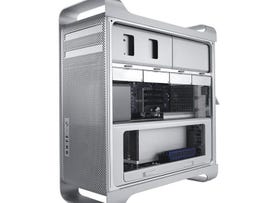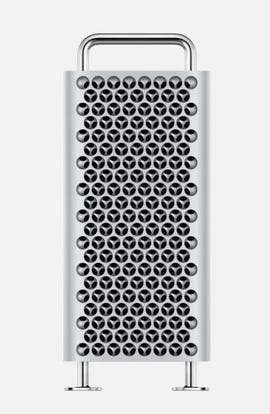Introducing my design for an Apple Silicon-based Mac Pro

Here’s what an Apple Silicon blade-based Mac Pro might look like.
Image: David Gewirtz
Here’s the scenario: Imagine you’re part of the Apple design team planning out a new Mac Pro based on Apple Silicon. Let’s further imagine that the Mac Mini Pro I proposed last week is real. That’s a beast of a machine, running M1 Pro or M1 Max processors, up to 64GB RAM, up to two 2TB flash storage, and 10GB Ethernet.
A lot of very serious pro work can be done with that hypothetical Mac Mini Pro. Work that might not be possible with one Mac Mini Pro certainly could be done with a large array of them. Certain big data projects could use a couple of racks of Mac Mini Pro boxes, talking over 10GB Ethernet, to map and reduce many parallel operations.
Given how capable the Mac Mini Pro is, and how it’s possible to do some very big projects by ganging them together, what might a Mac Pro add? Why would someone need a Mac Pro, and what could such a machine do that a cluster of Mac Mini Pros couldn’t?
That’s our design challenge. To look at designing our next Mac Pro, let’s look back at the earlier implementations.
What defines the Mac Pro DNA?
What defines a Mac Pro? Certainly, it’s CPU power. We’ll come back to that, because even in the Intel days, a random tower with a Xeon processor was not a Mac Pro. There was always a little somethin’-somethin’ that made Mac Pros special.
Let’s for the moment leave out the circular 2013 Mac Pro “trash can” incarnation. One of the reasons that the product failed to excite was because it didn’t really share true Mac Pro DNA.

Original “cheese grater” Mac Pro
The first Mac Pro debuted in 2006 and introduced the immediately iconic cheese grater tower design. In addition to the style notes, the 2006 through 2012 cheese grater designs offered a lot of drive bays for expansion, a lot of bus slots for expansion, a ton of RAM capacity, and — in what would be a hallmark of the Mac Pro’s industrial design — mechanisms that made adding and removing those internal components smooth as butter.
The premise behind the Mac Pro was simple: you could configure it to do anything, make it as powerful as you needed, and expand it as much as you could imagine — and do so with grace and ease. That’s the Mac Pro’s DNA in a sentence.

No love was lost on this design.
That was also the failure of the 2013 Mac Pro. There were no slots. You couldn’t really upgrade the video cards. For six years, the 2013 Mac Pro was stuck, primarily because Apple abandoned the “configure it to do anything” aspect of its DNA.
In 2019, Apple created an homage to the cheese grater Mac Pro. Expansion was back, as was Apple’s brilliant industrial design for adding and removing components. Apple even returned to the PCI Express bus, although by then, later generations of PCI Express had become substantially more capable than what was in the 2006 original model.
Note that when I talk about Mac Pro DNA, I’m not mentioning the price. In a sense, being brain-screamingly expensive seems like part of the Mac Pro DNA, but since many users are major film studios and labs, the price is not unreasonable. The key was that the Mac Pro removed the “what you can do with it” capability ceiling of the Mac and made the sky the limit.

Don’t deny it. You can see yourself grating some fine Tillamook cheddar on this, can’t you?
Apple
Since all the Mac Pros (except the anomalous trash can) have been so flexible and so expandable, it has been possible to upgrade the units over time, giving them a much longer usable life than they would have had if they hadn’t been expandable.
Conflict with the M1 architecture
Let’s reiterate what makes the Mac Pro DNA unique: you can configure it to do anything, make it as powerful as you need, and expand it as much as you can imagine — and do so with grace and ease.
Two of those characteristics are in direct conflict with the M1 architecture: configure it to do anything, and expand it as much as you can imagine.
The M1 Apple Silicon is a system-on-a-chip (or SOC). Everything of consequence is built inside the chip itself. It’s not just the CPU (or CPUs), it’s the RAM, the GPU(s), the neural processors — everything.
The M1 (whether the base model, the Pro or the Max) doesn’t allow you to add RAM. What you buy is what’s on the silicon wafer. It doesn’t allow you to change out the GPU. Now, yes, the Pro and Max allow you to run a whole bunch of wholly capable internal GPUs, but you still don’t have any flexibility.
As far as we know, there’s no M1 bus architecture, since it’s all inside the chip. So it’s unlikely that the M1 architecture supports adding a bus, and that means all sorts of special purpose boards that were possible in Mac Pros are not possible in M1-based machines. That also limits your ports. If you can add PCI Express boards, you can add all manner of additional ports. But if you can’t add to the bus because there’s no bus, there’s no way to add ports.
Flash storage isn’t built into the M1 chip itself, but it is surface mounted onto the tiny logic boards that come with M1-based machines. If you’re going to load up an array of storage devices, it’s going to be over USB C or Thunderbolt.
With all these limitations, it’s hard to think the M1 would make a practical foundation for a Mac Pro. A Mac Mini Pro can take the M1 architecture about as far as it can go, so it doesn’t really justify Apple introducing a Mac Pro based on even an M1 Max.
What’s possible with M2?
There is absolutely no doubt that Apple’s expertise with powerful SOC implementation is impressive. Apple provides a whopping 44 cores in its M1 Max SOC, split among performance and efficiency CPU cores, GPU cores, and neural (AI/ML) cores.
The more cores, the more it’s possible to parallelize certain problems. Cores allow threads to run nearly simultaneously, and many of today’s problems respond very well to parallelization, especially graphics, data crunching, AI, ML, and AR-related tasks.
It’s very likely that the M2 will substantially eclipse the M1. After all, Apple has been upping its processor game yearly, like clockwork, on the iPhone. Since the M1 is pretty much a fancy A15 Bionic, we can expect a new chipset next year in the form of an M2 that takes another performance leap.
But the M2 is still likely to be a SOC. If Apple allows for layering and stacking architectures inside the package like Intel’s EMIB (Embedded Multi-Die Interconnect Bridge) and Foveros, we might see the addition of specialty interfaces on the M2 that provide for support for something like a bus architecture, enabling memory or internal bus expansion.
But here’s the thing. If I were on Apple’s design committee, I’d probably argue against taking that approach. Tightly coupled SOCs with a lot of memory and processors contained within the package provides incredible performance capabilities. Once you’re offering 64 or 128GB RAM within the chip, a lot is possible.
Smart algorithms can coordinate a lot of data-intensive operations across a 10GB Ethernet network and with super-fast local flash storage. So, if I were on that committee, I might say that it doesn’t make sense to devote semiconductor design time to a fringe problem, when the mainstream product is going to be so powerful.
But that brings us back to the Mac Pro DNA question. If the M2 is merely a more powerful version of the M1 architecture, the Mac Mini Pro concept makes far more sense.
Innovating on the Mac Pro’s DNA
In my imagination, I’m giving the Mac Pro design team some corporate directives. I tell them that there’s not enough justification to create multiple SOC architectures for the M2. I tell them not to focus on the question of adding more RAM and swapping GPUs in a new Mac Pro.
In fact, I tell them, to stop thinking of the Mac Pro as a fancy PC tower. While the use of some PC components was appealing back in the day, Apple Silicon is a whole new deal.
Think instead, I tell them, of how the Mac Pro’s DNA could be applied to a new generation, based not on a PC architecture, but on a SOC architecture.
Instead, for example, of a PCI Express bus that lives on a motherboard, and separate memory, graphics, and CPU subsystems, think about how to get multiple SOCs communicating faster.
What about a design that takes the slots and expansion idea of a traditional motherboard, but connects blade SOCs at speeds considerably faster than 10GB Ethernet?
Create a SOC bus architecture that allows for super-fast communications between discrete M2s, as well as super-fast data transfer to terabytes or even petabytes of flash storage.
Make the Mac Pro expandable, but make it expand differently.
David’s take on an Apple Silicon Mac Pro
First, the cost is no object. The Mac Pro is a solution designed to eliminate performance ceilings for the biggest and most challenging projects. So if it costs a lot, but provides a lot, so be it.
At the core of the Mac Pro is the SOC bus. Where previous Mac Pros had various expandability interfaces (RAM slots, drive bays, PCI Express slots), this Mac Pro has one expandability interface: the SOC bus. The SOC bus is a bus designed to connect SOCs (outside of the package). It’s not as fast as what’s going on inside the package, of course, but it’s still considerably faster than anything possible with an external port, even Thunderbolt 3.
Let’s give it eight slots, just for this exercise. Those slots support different module types or blades.
M2 SOC Blade: The first, of course, is an M2 SOC board. This could come in a variety of configurations, with different amounts of RAM and various cores. You could get one with 16GB RAM, an 8 core processor with 2 efficiency cores, a 14 core GPU, and a 16 core Neural Engine. Or you could get an M2 SOC with 512GB RAM, a 32-core processor, a 32-core GPU, and a 32-core Neural engine.
Max configuration would be eight such M2 boards per Mac Pro. That would be a beast.
Flash Storage Blade: Next up is flash storage. Sure, it’s possible to add storage over Thunderbolt 4, but internal flash storage is still a whole lot faster. Using the SOC bus would make this storage outperform anything connected via ports.
Network Blade: It’s easy enough to drop a 10GB Ethernet port right on the Mac Pro’s main logic board. I have one on my 2018 Mac Mini. But what if you wanted four Ethernet ports? What if you wanted 100GB Ethernet? What if you wanted a fiber FDDI interface? For that, a SOC network blade would do the trick. Of course, Apple is unlikely to make a blade other than Ethernet, but we’ll talk about that below.
Port Expansion Blade: Sure, the stock Mac Pro logic board might include, say, four Thunderbolt 4 ports. But what if you need more? Or you need USB-A ports? Or you need a specialized interface port for some piece of specialized lab equipment? Port expansion cards have been a staple of PC builds forever. This is how the Apple Silicon Mac Pro could do it.
Open-Spec Blade: I know that making anything “open” is an anathema to Apple. But this is how the new Mac Pro could become a beloved high-end machine. If Apple were to publish the SOC bus spec and allow vendors to build specialized cards, the Mac Pro could do anything. Apple could oversee it with a developer program and even charge for licenses. For the Mac Pro, it doesn’t matter. All that needs to happen is for it to be possible.
A few final thoughts
We haven’t talked much about the actual case design of this machine, but since the core internal element is the blade architecture, the case doesn’t necessarily even need to open up. All the machine needs is an elegant way to slide in new blades.
I don’t see this needing to be in a tower form factor, unless heat dissipation becomes a big issue. Instead, I’d think this might look more like one of the Synology NAS boxes than a full tower. Another consideration might be for Apple to build a rack mount variant, so gangs of these machines can be used in a data center.
Going back to the role-playing thought experiment I introduced at the beginning of the article, I can see some serious pushback from the rest of the team about both the open standard for the SOC bus and even for the idea of making the machine expandable. After all, it might extend the life of the unit, eliminating the need for replacement for a longer time.
But here’s where I’d counter that argument. No one who would buy a MacBook Pro will decide to buy a Mac Pro instead. The Mac Pro is for the very top of the pro and extreme user pyramid. It’s meant to be designed so there’s no top end, no limit to what can be done with the Mac architecture.
It’s designed to keep the most high-end innovators using the platform. And at that level, meeting needs is what’s most important, especially since most of those users are used to paying (and, in fact, more than willing to pay) whatever it takes to get their jobs done.
So now it’s your turn. You’re in the same imaginary design meeting I’m in. Please share what your strategy would be in the comments below. I’m sure the rest of the team would love your insights.
You can follow my day-to-day project updates on social media. Be sure to follow me on Twitter at @DavidGewirtz, on Facebook at Facebook.com/DavidGewirtz, on Instagram at Instagram.com/DavidGewirtz, and on YouTube at YouTube.com/DavidGewirtzTV.





